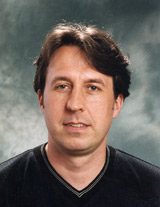Dr. Jean M.H. van den Elsen
Jean M.H. van den Elsen, Ph.D. is Lecturer in Molecular and Structural Biology, University of Bath, UK.
Despite efforts of prevention and control, infectious diseases remain an important global problem in public health, causing over 13 million deaths each year, worldwide. The aim of my research is to study the structural and physico-chemical characteristics of proteins, and their physiologically relevant complexes, that determine the elemental struggle between pathogenic microbes and the immune system of the host.
Current projects include:
Microbial Virulence Proteins
Enteric bacteria use a limited array of macromolecular systems to implement diverse pathogenic strategies, including the exploitation of molecules that regulate the actin cytoskeleton and the activation of apoptotic pathways to serve the pathogen. Many Gram-negative bacteria that cause disease in mammals share a strategy of delivering toxic proteins into the cytoplasm of the host cells known as type III secretion. Proteins delivered by the type III lethal injection machinery are found to stimulate complex host cell signal transduction pathways, resulting in a variety of cellular responses.
Complement System
The human complement system is comprised of about 20 plasma proteins and 10 receptors on cell membranes. Its primary function is to defend the host against microbial infections. Through their interactions, these proteins act as the primary humoral mediators leading to the immune clearance of antigen-antibody complexes and bacterial lysis. Additionally, the complement system plays an important role in the generation of an antibody response against foreign antigen, thereby providing a crucial link between the innate and adaptive immune systems. As an inflammation-inducing and cytolytic system, complement can also cause tissue damage in many diseases, especially in connective tissue disorders and renal diseases. On the other hand, deficiencies in the complement system are associated with a number of diseases, notably with an increased susceptibility to infection or immune-complex and autoimmune diseases.
Role of antibodies in autoimmune disease
Histidyl-tRNA synthetase (HisRS) has been found to act as a particularly important antigen in autoimmune diseases such as rheumatic arthritis or myositis. Although the causes of these autoimmune diseases are not known, the close association of these disorders with a spectrum of autoantibodies suggests an important role of these antibodies in the etiology of the disease. Of particular interest in this regard are antibodies that bind to HisRS. Findings that patient IgGs recognize at least three distinct epitopes on HisRS, strongly suggests that the immunological response at some point in the disease is directed against HisRS.
Future goals are to provide insights into the role of anti-HisRS antibodies in autoimmune disease through studies of the structure and function of HisRS and its interaction with these antibodies. The structure of human HisRS will also provide important insights in the basic mechanisms of the aminoacylation of tRNA, a key reaction in protein biosynthesis responsible for the fidelity of translation of genetic information.
Jean coauthored Structure of Golgi α-mannosidase II: a target for inhibition of growth and metastasis of cancer cells, Activity of Human IgG and IgA Subclasses in Immune Defense Against Neisseria meningitidis Serogroup B, Adhesion mechanism of human β-glycoprotein I to phospholipids based on its crystal structure, Antibody C219 recognizes an α-helical epitope on P-glycoprotein, Bactericidal Antibody Recognition of Meningococcal PorA by Induced Fit: Comparison of Liganded and Unliganded Fab Structures, and Interaction of Human Complement with Sbi, a Staphylococcal Immunoglobulin-binding Protein: Indications of a Novel Mechanism of Complement Evasion by Staphylococcus Aureus.
Jean earned his Ph.D. in Biopharmaceutics in 1996 at Utrecht University, The Netherlands. He was a postdoctoral fellow from 1997 to 1998 at Utrecht University, The Netherlands, and a postdoctoral fellow from 1998 to 2001, at Ontario Cancer Institute / University of Toronto, Canada.
Read Scientists crack 40-year-old DNA puzzle and point to “hot soup” at the origin of life, Decoding the genetic language of early life, and New Technique Detects Proteins That Make Us Age.
